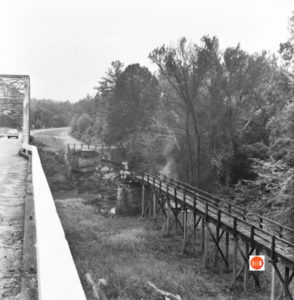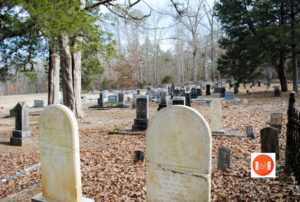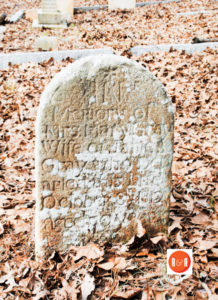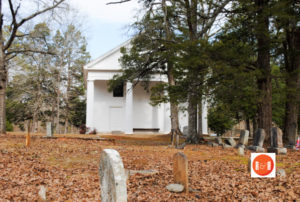Long Cane Road
City Directories and History: This lovely church is listed on the National Register of Historic Places. The lovely Long Cane Church measures 44 – 64 feet.
The Lower Long Cane Associate Reformed Presbyterian Church and Cemetery is associated with early settlement in the colonial and Revolutionary-era South Carolina backcountry and with the nineteenth-century establishment, decline, and revitalization of not only a single congregation, but also of the entire Associate Reformed Presbyterian denomination as a separate sect in the 
Presbyterian tradition. Its sanctuary, designed by William Henry Jones of Atlanta and dedicated in 1856, is an outstanding example of the Greek Revival style as applied to the simple meeting house form, while its cemetery of more than 500 graves includes burials of several charter members of Long Cane Associate Reformed Presbyterian Church from the period 1790-1856, when this church was exceptionally significant in the formation, growth, and development of the Associate Reformed Presbyterian Church as a whole. The church rests on a foundation of handmade brick piers, with a pierced brick curtain wall added at a later date. The façade features a fully engaged tetrastyle Roman Doric portico with an unadorned entablature and a steeply pitched pediment. Originally covered in wooden shingles, the roof was by ca. 1950 covered with diamond-shaped asbestos shingles. A small brick flue pierces the roof ridge at the center of the building. The interior auditorium is two stories in height with flush board walls and ceiling. The gallery features a continuously paneled knee wall, ranked wooden floors, and
simple handmade pews. Listed in the National Register October 6, 1999. [Courtesy of the SC Dept. of Archives and History]
“Long Cane (1780), McCormick County. Now often called “Lower Long Cane” to distinguish it from “Upper Long Cane” Southern Presbyterian Church on the outskirts of Abbeville. Long Cane Creek, which also gives its name to several other features of the life of the section, is a sizeable stream flowing through several counties.”
Information from: Names in South Carolina by C.H. Neuffer, Published by the S.C. Dept. of English, USC
Long Cane ARP Church –This current Greek Revival church building was constructed by William Henry Jones of Atlanta, a building contractor, and dedicated by Dr. Sloan on July 20, 1856. During the dedication Dr. Sloan preached from Habakkuk 2:20, “But the Lord is in His Holy Temple; let all the earth keep silent before Him”. The wooden structure is 44 x 64 feet with a 10 foot porch and gallery around three sides. It remains largely original except for additions of small rooms near the pulpit which were added in 1892 when the church discontinued the use of the Session House in back of the church, which had served also as a school. Its cemetery of more than 500 graves includes burials of several charter members of Long Cane Associate Reformed Presbyterian Church from the period 1790-1856, when this church was exceptionally significant in the formation, growth, and development of the Associate Reformed Presbyterian Church as a whole. The church rests on a foundation of handmade brick piers, with a pierced brick curtain wall added at a later date. The façade features a fully engaged tetra-style Roman Doric portico with an unadorned entablature and a steeply pitched pediment. Originally

Slave gallery at the Lower Long Cane Pres. Church. NR File Photo
covered in wooden shingles, the roof was by ca. 1950 covered with diamond-shaped asbestos shingles. A small brick flue pierces the roof ridge at the center of the building. The interior auditorium is two stories in height with flush-board walls and ceiling. The gallery features a continuously paneled knee wall, ranked wooden floors, and simple handmade pews. [Written and contributed to R&R by Bob Edmonds, 2015]

Mid 20th century postcard view of the old bridge. Courtesy of the AFLLC Collection – 2017
“Long Cane” occurs; and in 1848 the name is “Long- Cane.” The unhyphenated singular form seems to be more common than any other; thus the most frequent spelling today is naturally “Long Cane.” A further uncertainty is whether or not the name was first applied to a general region and afterwards came to be used for particular localities in the region, or whether “Long Cane” first meant a particular place such as “Long Cane Creek” and afterwards described a general area—a decision over the question is probably about as fruitless as trying to decide if the chicken or the egg came first. The inquirer becomes still more puzzled when he tries to unravel the relationship between Long Cane Creek and Little River. Sometimes the creek is regarded as a tributary to the river; again the two streams are regarded as separate entities, with one just accidentally touching the other; and also (in fact, often in the early history of the colony) Little River is called “The North-West Branch of Long Cane.” An 1820 survey identifies “Little River” as the stream to which the name nowadays is attached; an 1836 map confuses Long Cane Creek with 1858 Little River; the historian McCrady refers to “both sides of Little River” and subsequently to the “North Branch of Long Cane, to wit, Little River”; another modern historian speaks of the “place where the Long Cane Creek and the Northwest Fork meet”; still another modem writer mentions “Little River, of which Long Cane Creek was a branch”; the language of the deed to the tract of land which Governor Glen, in 1747, purchased from the Cherokees for white settlers says that the purchase lay “south and easterly of a certain branch or stream commonly called Long Canes . . . from the head of said branch and down it until it falls into the Savannah River.” (Information from: Names in South Carolina by C.H. Neuffer, Published by the S.C. Dept. of English, USC)
Diary of Chaplain John H. Simpson: His most extended trip began when he was with Chaplain J. Monroe Anderson on the battlefield at Fredericksburg on December 13, 1862. He found George Chiles from the Long Canes area of Abbeville County, with a shoulder wound. He made a bed of straw, visited him on the battlefield and took Chiles on the train to a Richmond hospital. Simpson visited Chiles for months until he took the improved soldier to the Medical Director of Samaritan Hospital and obtained a transfer to the Columbia hospital. On April 3, 1863 Simpson, Chiles and “Smith,” a North Carolina soldier on medical furlough, traveled to Weldon the first day. On April 4th they reached Raleigh by 4:00 p. m. and Simpson managed to get two seats for each wounded man on the overnight train to Charlotte. Smith reached his destination at a whistle-stop about daybreak while Simpson and Chiles debarked at Charlotte. They spent Sunday in a Charlotte hotel so that Chiles could rest and sleep. On Monday Chiles and Simpson took the train to Chester, arriving at noon, and ate a leisurely dinner from Simpson’s home table. In the afternoon they rode the train from Chester to Columbia where they went to a Wayside Hospital for the night.
Echoes of Mercy – Whispers of Love: Diaries of John Hemphill Simpson, 1861, 1862. 1863 and 1865 War Between the States (Greenville, South Carolina, Associate Reformed Presbyterian Foundation, Inc., 2001),
A stop on the Little White Church Jaunt – A Driving Tour
Stay Connected
Explore history, houses, and stories across S.C. Your membership provides you with updates on regional topics, information on historic research, preservation, and monthly feature articles. But remember R&R wants to hear from you and assist in preserving your own family genealogy and memorabilia.
Visit the Southern Queries – Forum to receive assistance in answering questions, discuss genealogy, and enjoy exploring preservation topics with other members. Also listed are several history and genealogical researchers for hire.
User comments welcome — post at the bottom of this page.
Please enjoy this structure and all those listed in Roots and Recall. But remember each is private property. So view them from a distance or from a public area such as the sidewalk or public road.
Do you have information to share and preserve? Family, school, church, or other older photos and stories are welcome. Send them digitally through the “Share Your Story” link, so they too might be posted on Roots and Recall.
Thanks!
IMAGE GALLERY – Blythe Collection, 1982
- Burned remains of the Covered Bridge – Blythe Collection
- Burned remains of the Covered Bridge – Blythe Collection


















